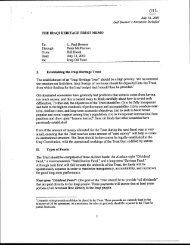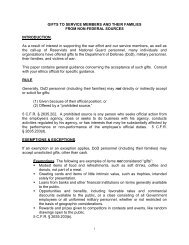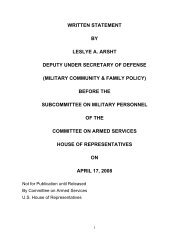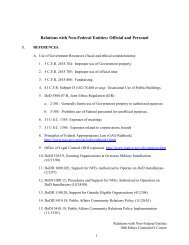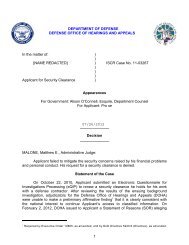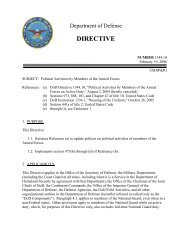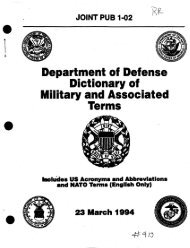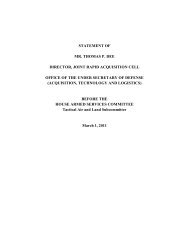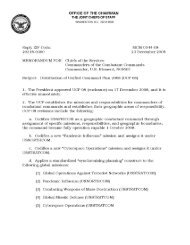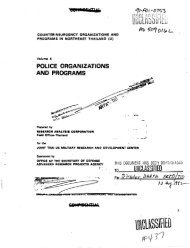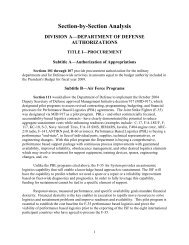dod tactical herbicide sites - United States Department of Defense
dod tactical herbicide sites - United States Department of Defense
dod tactical herbicide sites - United States Department of Defense
You also want an ePaper? Increase the reach of your titles
YUMPU automatically turns print PDFs into web optimized ePapers that Google loves.
eing evaluated, i.e. potential exposures. The section on “Sources” provided theinformation that was described and assessed.The Period from 1963 to 1967: Developing the Spray Systems and MultipleHerbicides for Supporting Combat Operations in VietnamThe second period was the period in which new spray equipment and new formulations<strong>of</strong> <strong>tactical</strong> <strong>herbicide</strong>s were developed and thoroughly tested in different geographicallocations that were applicable to the subtropical and tropical conditions encountered inVietnam. This research supported the “Operational Phase” <strong>of</strong> the Army Chemical Corpsand the Air Force Operation RANCH HAND deployment <strong>of</strong> <strong>tactical</strong> <strong>herbicide</strong>s in thecombat environment <strong>of</strong> Vietnam. The Leaflet Series from Site 10 through Site 21describe the development <strong>of</strong> various aerial spray systems at Eglin Air Force Base,Florida, and the Dugway Proving Ground, Utah, for the Army Chemical Corps(helicopters and a proposed fixed-wing Defoliant System), and the Air Force C-123Umodifications for RANCH HAND combat spray missions. In addition, this series <strong>of</strong>Leaflets describes the continual efforts <strong>of</strong> the Army Chemical Corps Laboratories at FortDetrick to develop and test new <strong>tactical</strong> <strong>herbicide</strong>s, including fine-tuning the rates <strong>of</strong>applications required to control the vegetation encountered in Vietnam and throughoutSoutheast Asia.The Use <strong>of</strong> Tactical Herbicides in Korea in 1968, and the “Camille” Incident inMississippi in 1969The only “military use” <strong>of</strong> <strong>tactical</strong> <strong>herbicide</strong>s “outside” <strong>of</strong> Southeast Asia was in 1968when the Korean and US Governments agreed to provide Herbicide Orange andHerbicide Blue for vegetation control adjacent to the Demilitarized Zone in Korea.Leaflet 22 describes this activity and the involvement <strong>of</strong> Korean and US militarypersonnel. Leaflet 23 describes the incident in August 1969 at Gulfport, Mississippiwhere hundreds <strong>of</strong> drums <strong>of</strong> Herbicide Orange and Herbicide Blue were destroyed or lostdue to the damaging winds <strong>of</strong> Hurricane “Camille.” This Leaflet also assesses theinvolvement <strong>of</strong> personnel from the Army Corps <strong>of</strong> Engineers and the Air Force LogisticsCommand in the cleanup operations.The Period from April 1972 – March 1977: Disposal Options for the SurplusHerbicide Orange Remaining After the Vietnam WarThis time period was the period in which the military evaluated various options for thedestruction <strong>of</strong> the surplus Herbicide Orange that was returned to the <strong>United</strong> <strong>States</strong> inApril 1972 from Vietnam (Operation PACER IVY), or was in storage at the NavalConstruction Battalion Center (NCBC), Gulfport, Mississippi in 1969. In August 1966,the <strong>United</strong> <strong>States</strong> Air Force Logistics Command took over the responsibility formanaging the growing and continued procurement requirements for <strong>tactical</strong> <strong>herbicide</strong>s inSoutheast Asia. With the abrupt cessation <strong>of</strong> the use <strong>of</strong> Herbicide Orange in Vietnam inApril 1970, the 7 th Air Force in Vietnam was given the task <strong>of</strong> consolidating theremaining Herbicide Orange stocks in Vietnam (Operation PACER IVY), and5



